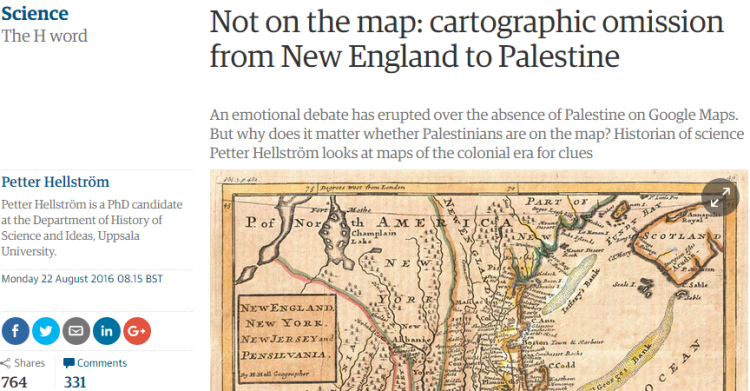Written by Richard Millett

The Guardian’s weapon of choice on Monday against the Jewish state was maps with Petter Hellström, a PhD candidate at the Department of History of Science and Ideas, Uppsala University, claiming, in the Science section, that Google “chose not to mark Palestine on their maps…to stay impartial in the eyes of customers and the surrounding society…their fellow westerners.”
Once again this article would have been more at home in the opinion section.
Hellström complains that Google’s Map of Israel shows Israeli population centre Ma’ale Adumin on the West Bank but “not even major (Palestinian) ones like Gaza City, Khan Yunis or Nablus”.
He then reproduces two maps of North America from 1614 and 1729 which he claims “made the colonists visible at the expense of the indigenous population” and which he calls “instruments of colonial legitimisation”, the obvious inference being that Google is doing the same to the Palestinians.
He also reproduces an Israeli government map which doesn’t delineate the West Bank and Gaza as separate from Israel while accepting that the Palestinians do the same with their maps but giving the Palestinian action a more innocent gloss:
“Palestinian maps often label the whole country as Palestine – effectively a refusal to acknowledge the development since 1948.”
Hellström then invokes anti-Zionist Israeli historian Meron Benvenisti who “described the process with which the Israeli state Hebraized the place-names of the country they had conquered”.
Hellström quotes Benvenisti:
“The Hebrew map of Israel constitutes one stratum in my consciousness, underlaid by the stratum of the previous Arab map.”
Hellström also invokes that ambiguous 173 year old phrase originated by Christian evangelicals “a land without a people for a people without a land” but which Hellström attributes more directly to “the architects of Israel.” The phrase is now commonly employed as an epithet against Israel’s supporters.
Hellström took his cue from the Forum of Palestinian Journalists when they “accused Google of removing Palestine from their maps.”
His main concern is “whether Palestine and its people exist at all” and is under the impression that there was once a country called Palestine because “It is there on old paper maps, of the Holy Land, of the Roman and Ottoman empires, of the British mandate.”
But it was the “British Mandate for Palestine”, merely an administrative name. And on Ottoman maps Palestine was subsumed as a part of southern Syria.
Meanwhile, Palestine’s current status is as a UN non-member observer state having failed to join the international body as a full member state.
Irrespective of all the above I was bemused anyway because when you play around with Google maps of Israel and Palestine and zoom in closer than Palestinian population centres do appear.
Furthermore, Google’s map for Palestine has a sidebar showing Wikipedia’s definition of Palestine’s current UN status. Google, itself, even puts Palestine’s capital at “East Jerusalem” instead of the, arguably, more accurate Ramallah.
Here’s the link to Google’s map of Palestine:
I wrote to Hellström for clarification of his criticism. His response (which I publish in full below at his request if I was going to quote from it) was that Israeli population centres are disproportionately represented, that the Google sidebar is, depending on your device and settings, not necessarily always available, and that the content of Wikipedia is not stable.
He has a point to the extent that Google’s map of Palestine isn’t labelled. There is an argument that it could be labelled “Palestinian territories” or, “administered Palestinian territories” with delineated Areas A, B and C or, even, “non-member observer state”. Some might prefer “Judea and Samaria”.
It would just be inaccurate to refer to it as Palestine.
Hellström’s article could, quite validly, have gone down this road of discussion, but by directly implicating Israel and its creation in all this and suggesting that Google might have some financial agenda is to go down a far more sinister route.
Petter Hellström’s response to my email (23rd August 2016):
Dear Richard,
Many thanks for your e-mail. I am only happy to clarify what I wanted to say in the article; the short online format is not always helpful to give full disclosure of an argument.
First, it is not my main contention that the name of Palestine is absent from Google Maps. My argument is rather that this absence – like the relative absence of Palestinian place names – is significant, that it can tell us something, and that it matters.
If you search for Israel on Google Maps, the map centres on the State of Israel. It displays Israeli place-names, both in Israel proper and on the West Bank (Ma’ale Adumin), but no Palestinian place names, even as several Palestinian urban centres are significantly larger than the Israeli urban centres labelled (most striking is the labelling of Yotvata, pop. 700,while Gaza City, pop. 515,556, is not labelled; but even on the Palestinian territories there is a preference for Israeli urban centres, since only Ma’ale Adumin is labelled on the West Bank, although significantly smaller than several of the adjacent Palestinian urban centres). Since 19 August, in response to criticism, Google Maps also labels the Gaza Strip and the West Bank (even as it is not clear what status they enjoy). As you zoom in on the region, Palestinian place names start to appear along more Israeli place names. However, their respective representation is still disproportionate (Israeli urban centres show up at a much lower resolution than Palestinian urban centres of comparable size).
Now, if you search for Palestine on Google Maps, as you did, the map centres instead on the West Bank (you are in fact shown the same map image as if you searched for the West Bank). This map image is consequently of higher resolution, and thus more place names are shown, both in Israel and on the Palestinian territories. Their disproportionate representation is still apparent (the map image is, in fact, the same as the one you get if you first search for Israel, zoom in, and move the centre from Israel proper to the West Bank).
The Google Maps interface sometimes shows – depending on your settings and your device – a sidebar with a link to Wikipedia. It is Wikipedia, not Google Maps, that describes Palestine as ”a de jure sovereign state in the Middle East that is recognized by 136 UN members and since 2012 has a status of a non-member observer state” and which states East Jerusalem as its capital. The content of Wikipedia is not stable but changing depending on contributors. As far as I know, Google exerts no power over it, they merely provide the link. If you search for Jerusalem on Google Maps, it is clearly stated as located in Israel, not as in Israel and in Palestine.
In conclusion, Google Maps shows Israel but not Palestine, although both are states recognised by the UN as well as by most of the world’s independent states (Palestine is presently recognised by 136 and Israel by 161 UN member states). Moreover, and importantly, Google Maps shows Israeli presence in Israel and the Palestinian territories disproportionately more than it represents Palestinian presence.
Having said all this, it was not the purpose of my article to pass judgment on Google or to suggest how they should produce their maps in the future. Others are more willing to do this. My objective was rather to say that Palestine’s absence on Google Maps, like the relative absence of Palestinians, has precedents in the history of cartography; my example was New England, both because I thought it would speak to an Anglophone and predominantly British and American audience, but also because Harley made his argument about New England in reference to Israeli policies). My objective was also to say that history shows us that cartographic omission matters, especially when a state or country is in military occupation of another people, whose lands it is confiscating.
I hope this clarifies my argument. Again I thank you for your polite e-mail.
If you publish my reply on your blog or in any other forum, I would appreciate that you publish it in its entirety, rather than using only parts of it.
Best regards,
Petter Hellström





